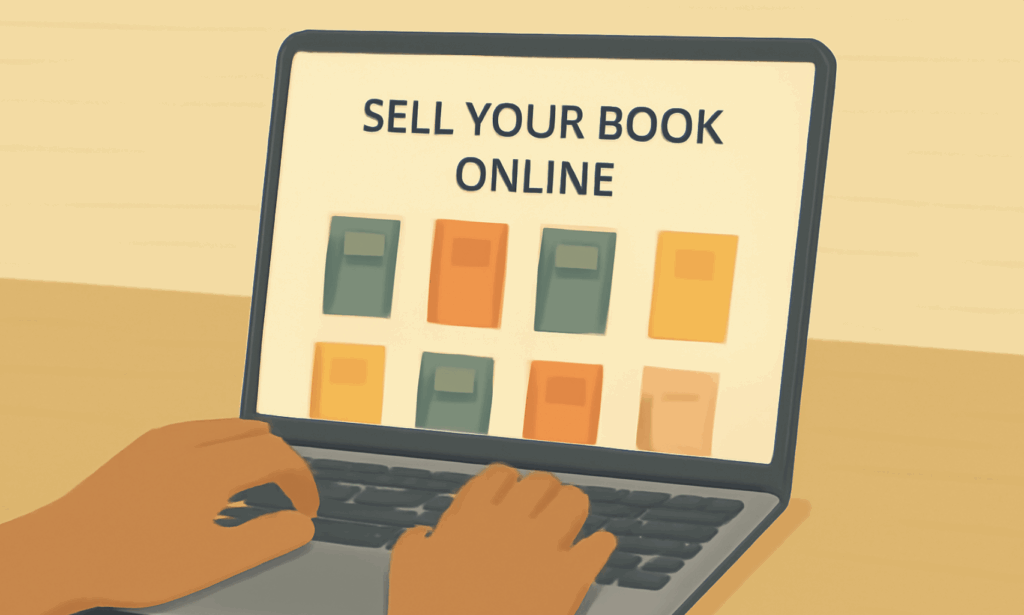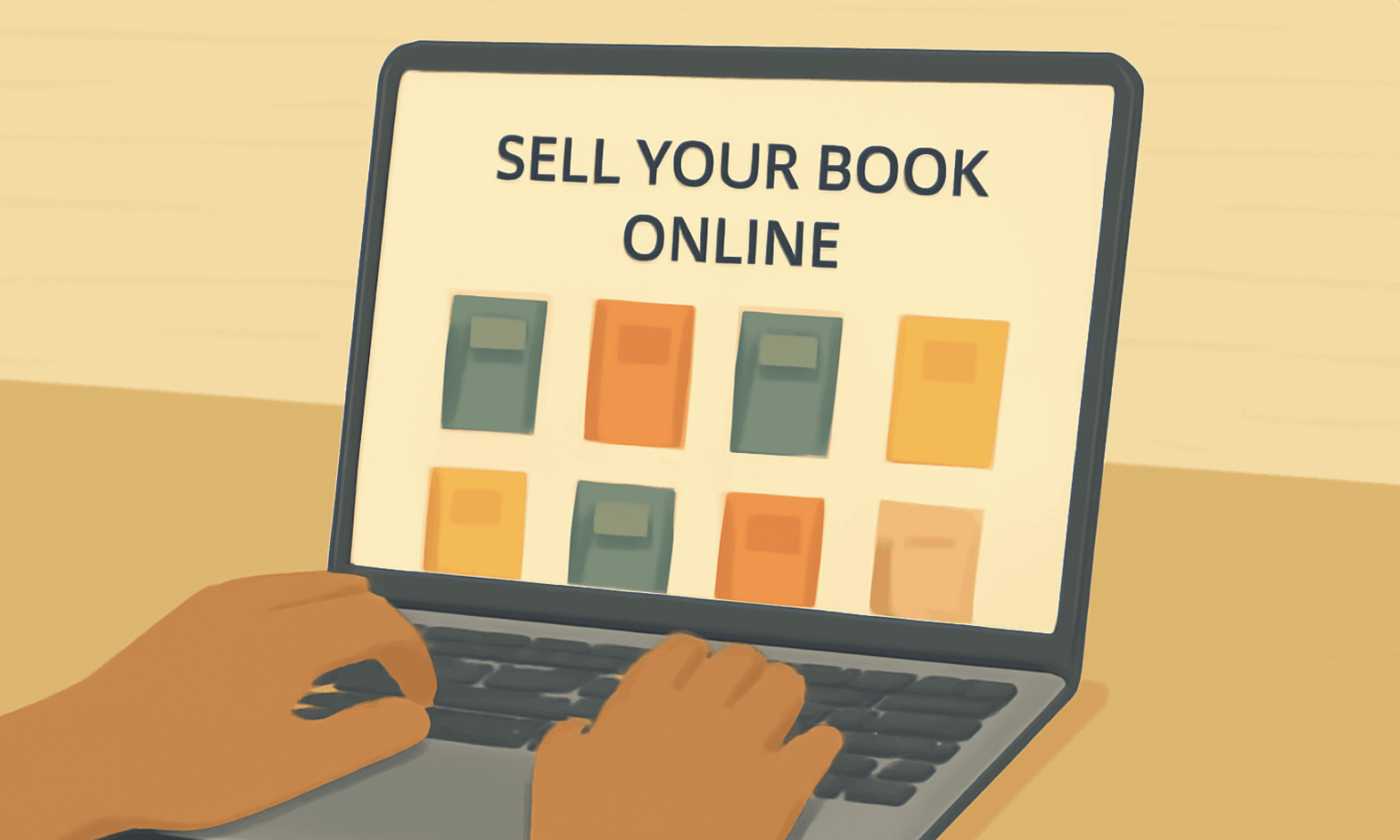Selling books online has never been easier, and in today’s digital world, it’s one of the best ways to get your work into the hands of readers around the globe. Whether you’re a first-time author or a seasoned pro, selling your book online opens up a world of opportunities. But with so many platforms out there, it can be tough to know where to start.
In this guide, we’ll explore the best way to sell books online, from Amazon to other popular platforms, and share practical tips on how to effectively market your book.
Why Sell Books Online?
Selling books online isn’t just a trend, it’s become a game-changer for authors. Gone are the days when getting your book in front of readers meant dealing with expensive print runs, limited distribution, and the gatekeepers of traditional publishing. Now, with just a few clicks, your book can reach a global audience without ever leaving your home office (or your couch).
Here are a few reasons why selling books online is a no-brainer for authors:
- Global Reach: The internet is a big place, and platforms like Amazon, IngramSpark, and others give you access to a worldwide market. Whether you’re targeting readers in your neighborhood or across the globe, online sales make it easy to reach anyone with an internet connection.
- Low Startup Costs: Traditional publishing often involves hefty upfront costs—printing, storage, and distribution. When selling online, especially through print-on-demand services, you don’t need to worry about that. You can publish your book with minimal upfront investment and only pay for copies as they sell.
- Complete Control: When you sell your book online, you’re the boss. You set the price, choose the platforms, and decide on your marketing strategy. Plus, with self-publishing, you maintain full rights to your work. You’re not giving up creative control or royalties to anyone else.
- 24/7 Sales: The beauty of selling online is that it’s not restricted by store hours or geographic location. Your book is available for purchase around the clock, from anywhere in the world. That’s a huge advantage over physical bookstores, where your book might only be available during business hours.
By selling your book online, you’re not just tapping into the digital marketplace, you’re opening the door to a much broader audience and giving yourself more control over your publishing journey. It’s a win-win for authors looking to make a mark in today’s market.
Your Publishing Journey Awaits – Start NowThe Best Way to Sell Books Online
Now that you know why selling books online is such a great opportunity, let’s dive into the best ways to actually do it. There are many platforms and strategies you can use, but it all boils down to a few key tactics that will maximize your reach and sales potential. Whether you’re just starting out or looking to expand your online presence, here are the most effective ways to sell your books online:
Amazon’s Kindle Direct Publishing (KDP)
If you want to sell your book online, Amazon is the elephant in the room, and for good reason. Amazon’s Kindle Direct Publishing (KDP) is one of the most powerful tools for self-published authors. It allows you to publish eBooks and print-on-demand paperbacks and get them listed on Amazon’s massive marketplace.
Why it works:
- Massive Audience: Amazon is the largest online retailer in the world, meaning your book gets access to millions of potential readers.
- Print-on-Demand: No need for inventory. You only pay for the books that are ordered, and Amazon handles the printing and shipping.
- Royalties: KDP offers a competitive royalty rate, giving you up to 70% for eBook sales and 60% for paperbacks (minus printing costs).
Tip: Make sure to optimize your book’s product page on Amazon, use relevant keywords in your book description, choose the right categories, and make sure your cover design stands out.
Sell Directly Through Your Own Website
Having your own website gives you full control over how your book is marketed and sold. By offering your book directly to readers, you can skip the middleman and keep a larger percentage of the sale.
Why it works:
- Direct Relationship with Readers: You can build your brand and create a loyal following. Readers who buy directly from you are more likely to return for future books.
- Better Profit Margins: By cutting out third-party platforms, you retain more of the profits per sale.
- Customization: You can offer exclusive content, special editions, or signed copies that might entice readers to purchase directly from you.
Tip: Use platforms like Shopify, Squarespace, or WordPress with e-commerce plugins to create an easy-to-navigate online store. Don’t forget to promote your website through social media, email lists, and other marketing channels!
IngramSpark for Broader Distribution
While Amazon might dominate the eBook world, IngramSpark offers great distribution options for both eBooks and print books, particularly if you’re looking to get your physical book into brick-and-mortar bookstores or libraries.
Why it works:
- Wider Distribution: IngramSpark allows you to distribute your book to thousands of retailers, libraries, and wholesalers around the world, including Barnes & Noble and indie bookstores.
- Professional Print Options: IngramSpark offers various print options, including hardcover formats and custom binding, giving your book a more polished, professional look.
Tip: IngramSpark has a small setup fee, but it can be well worth it if you’re serious about reaching a larger, more diverse audience. Just make sure you’re ready to handle the logistics of print distribution if you’re going for broader exposure.
Utilize Social Media and Content Marketing
Selling books online isn’t just about listing them on a platform. Effective marketing plays a huge role in driving traffic to your book’s sales page. Social media and content marketing are two powerful ways to promote your book to your audience.
Why it works:
- Reach a Targeted Audience: Social media platforms like Instagram, Twitter, Facebook, and TikTok are perfect for connecting with potential readers who are interested in your genre or niche.
- Build Relationships: Engaging with readers and followers creates a loyal community. The more people know about you and your writing process, the more likely they are to support your book.
- Content Marketing: Sharing blog posts, book excerpts, behind-the-scenes content, and writing tips on your website or social platforms helps keep your audience engaged and excited about your book.
Tip: Create a content calendar for consistent engagement and consider running paid ads on Facebook or Instagram to increase visibility.
Sell on Multiple Platforms
While Amazon is the go-to for many authors, it’s not the only platform available. You should consider listing your book on multiple platforms to maximize exposure and sales.
Why it works:
- More Reach: Different readers prefer different platforms. By selling your book on sites like Barnes & Noble Press, Apple Books, and Kobo, you’ll reach readers who may not shop on Amazon.
- Diversification: Relying on one platform can be risky, especially if there are changes in algorithms or policies. By spreading your sales across multiple platforms, you reduce that risk.
Tip: Use aggregators like Draft2Digital or Smashwords to distribute your eBook to multiple retailers at once, saving time and effort.
By combining these methods, you’ll have a comprehensive strategy for selling your book online. Whether you choose to sell exclusively on Amazon, take control of your own website, or explore other platforms, the key is to get your book in front of as many readers as possible—and make it as easy as possible for them to buy.

How to Sell Your Books Online: Step-by-Step
Selling your book online might seem daunting at first, but breaking it down into manageable steps makes the process much easier. Whether you’re selling an eBook, paperback, or both, following a simple step-by-step guide will help you navigate the journey from manuscript to sales. Here’s how you can start selling your book online today:
Step 1: Choose a Platform
The first step in selling your book online is deciding where you’ll sell it. There are several platforms available, and each offers its own advantages. Amazon KDP is great for both print and eBooks, but other platforms like IngramSpark, Barnes & Noble Press, and Apple Books also offer valuable opportunities.
Start with one or two platforms that fit your needs and scale as you grow. Amazon KDP is often a good starting point due to its massive reach, but using a combination of platforms can help expand your audience.
Step 2: Format Your Book for Each Platform
Each platform may have different formatting requirements, so it’s important to make sure your book looks great across all devices and formats. If you’re publishing an eBook, make sure it’s formatted in a compatible file type (usually EPUB or MOBI). For print books, check the trim size, bleed settings, and resolution of your images.
You can format your book yourself using tools like Scrivener or Reedsy, or hire a professional formatter if you want a polished, professional look.
Step 3: Design a Compelling Book Cover
Your book cover is often the first thing a potential reader will see, so make it count. A high-quality, eye-catching cover can make all the difference in attracting buyers. If you’re not a designer, consider hiring a professional to create a cover that reflects your book’s genre and tone.
Your cover should be optimized for both digital and print formats. Ensure that the text is legible at smaller sizes for online listings and that it looks sharp in both thumbnail and full-screen views.
Step 4: Write an Engaging Book Description
Your book description is one of the key factors that will persuade readers to purchase. Keep it concise, engaging, and focused on the value your book offers. Highlight what makes your book unique, and don’t forget to include keywords that will help your book appear in relevant search results.
Write a description that appeals to your target audience. For fiction, focus on the story’s hook, while for non-fiction, emphasize the benefits and takeaways. You can also test different descriptions on various platforms to see what resonates best.
Step 5: Set a Competitive Price
Pricing your book can be tricky, set it too high, and you might scare off potential buyers; set it too low, and you risk undervaluing your work. Research what other books in your genre are priced at and aim for a competitive yet fair price.
Consider pricing strategies such as offering your book at a lower introductory price to generate buzz, or offering discounts on future releases for readers who purchase your first book.
Step 6: Optimize for Discoverability
Selling a book online is not just about listing it on a platform. You need to make sure it’s visible to the right audience. Use relevant keywords in your book’s title, description, and metadata. Consider writing blog posts, guest articles, or offering sample chapters to attract readers to your book.
Tip: Use platforms like Goodreads to promote your book, gather reviews, and connect with potential readers. Participate in online communities and groups related to your genre to build awareness.
Step 7: Promote Your Book
Once your book is live and available for purchase, it’s time to start promoting. Social media, email newsletters, and author websites are powerful tools to get the word out. Consider running paid ads on Facebook, Amazon, or Goodreads, especially if you have a launch or special promotion.
Don’t just promote your book once, keep up the momentum by engaging with your readers on social media, running giveaways, and offering promotions. A book launch can generate initial buzz, but consistent promotion will help you maintain visibility.
Step 8: Monitor and Adjust Your Strategy
After your book is published, it’s important to track its performance. Most platforms provide analytics so you can see how your book is performing in terms of sales, click-throughs, and more. Based on this data, you can adjust your marketing strategy, update your book description, or change your pricing to improve sales.
Experiment with different marketing tactics, track what works, and continuously refine your approach. Even successful authors are always tweaking their strategies to stay on top.
Common Mistakes to Avoid When Selling Books Online
While selling books online can be incredibly rewarding, there are some common mistakes that many authors make along the way. Avoiding these missteps can save you time, money, and a lot of frustration. Let’s look at some of the most common pitfalls to watch out for and how to steer clear of them.
Neglecting to Optimize Your Book Listing
A well-optimized book listing can make all the difference when it comes to visibility and conversions. If your book description is generic, lacks keywords, or doesn’t effectively highlight your book’s unique selling points, you could be missing out on potential readers.
How to avoid it:
- Craft a compelling book description: Use a strong hook at the beginning and make sure to highlight key details about your book, such as the plot, characters, or benefits.
- Optimize with keywords: Use relevant keywords in your book’s title, subtitle, and description to improve discoverability in search results.
- Include a call-to-action: Encourage readers to buy your book by providing a clear and engaging call-to-action in the description.
Skipping the Proofing Step
Once your book is live, it’s easy to assume everything looks perfect, but errors and formatting issues can easily slip through. These mistakes can be even more glaring in a printed book than on a computer screen.
How to avoid it:
- Order a proof copy: Whether you’re printing or publishing digitally, always review a proof of your book before releasing it.
- Double-check formatting: Review your book’s layout on different devices or in print to ensure no text is cut off, margins are aligned, and images are clear.
- Proofread one last time: Read through your manuscript again (and maybe even have someone else review it) to catch any overlooked errors.
Underpricing Your Book
While it may be tempting to undercut the competition by pricing your book lower than similar books, this can undermine the value of your work. Setting your price too low can make potential buyers question the quality of your book, and you might not be making enough to cover your time and effort.
How to avoid it:
- Research your market: Look at similar books in your genre and consider pricing your book competitively, not too cheap but not overpriced either.
- Consider your royalties: Take into account the royalties and fees from the platform you’re using to set a price that allows for a reasonable profit while remaining attractive to readers.
Ignoring Marketing After Launch
It’s easy to assume that once your book is available online, the sales will start rolling in. However, launching your book is just the beginning—ongoing marketing is key to maintaining visibility and driving sales over time. Without consistent promotion, your book could easily fade into obscurity.
How to avoid it:
- Create a marketing plan: Have a long-term strategy in place, including social media promotion, email marketing, and outreach to bloggers or influencers.
- Keep engaging with readers: Even after launch, stay active on social media, respond to reviews, and engage with your community to keep your book in the spotlight.
Failing to Build an Author Platform
Many authors focus so much on writing their book that they forget to build a platform to promote it. A strong author platform, such as a website, blog, or social media presence, is essential for driving sales and connecting with readers.
How to avoid it:
- Start early: Build your platform while you’re writing your book. Engage with readers on social media, start a blog, or create an author website.
- Offer value: Share content related to your book’s themes, writing tips, or other relevant topics to keep your audience engaged and invested in your work.
Not Tracking Sales and Adjusting Strategies
Without tracking your sales and analyzing data, it’s hard to know what’s working and what’s not. Are your ads performing well? Are your promotions attracting new readers? Without these insights, it’s easy to keep using the same approach, even if it’s not yielding results.
How to avoid it:
- Use analytics: Monitor your book’s performance through the reporting tools available on platforms like Amazon KDP, Google Analytics, and social media insights.
- Adjust your strategy: Based on the data, tweak your pricing, marketing efforts, or promotional tactics. Continuous learning and adjustment are key to improving your book’s sales over time.
Not Offering a Compelling Call-to-Action
If your book listing or marketing materials don’t clearly tell potential readers what to do next, you could be missing out on valuable sales. A strong call-to-action (CTA) encourages readers to take immediate action, whether it’s to buy the book, leave a review, or share it with others.
How to avoid it:
- Be clear and direct: Your CTA should be simple and to the point. For example, “Buy now and start reading today!” or “Download your copy now and get 20% off!”
- Make it enticing: Offer something extra, like a bonus chapter, free resources, or an exclusive discount for those who act quickly.
Remember, the road to consistent sales involves more than just publishing your book, it’s about keeping it in front of readers, adjusting your strategies as you go, and building a loyal fanbase.
Start Selling Your Book Online Today
Now that you have a clear roadmap for selling books online, it’s time to take action. Whether you decide to use Amazon, your own website, or multiple platforms, the key to success is persistence, effective marketing, and continual engagement with your audience. The online book market is vast, but it’s also filled with opportunities for authors who are willing to put in the effort to promote their work.
Remember, the journey doesn’t end once your book is live. Keep optimizing your listings, experimenting with different marketing strategies, and engaging with your readers. The more you invest in promoting your book and building your author brand, the more success you’ll see.
So, what are you waiting for? Your book is ready to be discovered, and readers are just waiting to find it. Take the first step, put your book out there, and start selling today. The digital marketplace is your oyster, now go and sell your book like the authorpreneur you were meant to be!
FAQ: Sell Books Online
Q: How do I start selling my book online?
To start selling your book online, you’ll need to choose a platform, such as Amazon Kindle Direct Publishing (KDP), IngramSpark, or your own website. After that, format your book for the platform, design an engaging cover, write a compelling book description, set a competitive price, and begin marketing your book to your target audience.
Q: What is the best platform to sell books online?
The best platform for selling books depends on your goals. Amazon KDP is widely used for both eBooks and print books due to its massive audience. However, platforms like IngramSpark or Barnes & Noble Press can help distribute your book to additional retailers. A personal website can also be a great way to sell directly to your readers.
Q: How can I sell my book on Amazon?
To sell your book on Amazon, sign up for an Amazon KDP account, format your book according to Amazon’s specifications, upload your manuscript and cover, write a compelling description, and set a price. Once everything is set, your book will be available for purchase on Amazon in both eBook and print formats (if you choose print-on-demand).
Q: Do I need to hire someone to design my book cover?
While it’s not mandatory, hiring a professional book cover designer can significantly increase your book’s appeal. A well-designed cover helps attract potential readers and gives your book a polished, professional look. If you’re on a budget, there are also design tools like Canva that allow you to create your own cover with templates.
Q: How can I market my book online?
Effective book marketing includes strategies like building a strong social media presence, creating an email list, running paid ads on platforms like Facebook and Amazon, getting reviews from readers, and engaging with online communities related to your book’s genre. Consistent promotion will help keep your book visible to potential buyers.
Q: Can I sell my book on multiple platforms?
Yes, you can sell your book on multiple platforms. Many authors use Amazon for its vast reach and then also distribute through services like IngramSpark, Barnes & Noble Press, or Smashwords. Using multiple platforms allows you to reach different audiences, increasing the chances of sales.
Q: How do I track my book sales online?
Most platforms, like Amazon KDP and IngramSpark, provide detailed analytics to track your book sales. You’ll be able to see how many copies you’ve sold, where your book is selling, and your royalties. These insights can help you adjust your marketing strategy to maximize sales.






